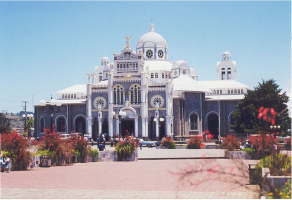Top 10 Most Beautiful Historical Sites in Vietnam
The natural beauty and rich culture of Vietnam entice most visitors. Green rice fields, a gorgeous shoreline, vast cave systems, and the interesting activity ... read more...of the Mekong delta. Vietnam is another nation with a long history and old traditions as well. A journey to Vietnam would be incomplete without visiting historical places that depict the gloomy side of a country that has been deeply influenced by conflict for millennia. This list includes the top historical sites to see in Vietnam, ranging from the first national university to an outrageous prison complex where thousands of Vietnamese people are inflicted or simple hand-dug tunnels. Let's explore the top 10 following beautiful historical sites in Vietnam.
-
One of the most beautiful historical sites in Vietnam, Temple of Literature is widely regarded as one of Hanoi's most magnificent tourist sites. The edifice was built in 1070 as the first university and has survived several conflicts. Until recently, the Temple of Literature was a remarkable example of Vietnamese traditional architecture. This ancient site includes a lake of books, the Well of Heavenly Clarity, stone steles, pavilions, and passageways originally utilized by royal families. When you visit the Temple of Literature, you will be able to see spectacular architecture as well as many historical treasures from the Ly and Tran dynasties. Aside from that, the Temple of Literature has seen hundreds of doctors graduate. Successful graduates have their names and accomplishments etched on a stone.
From the exterior, the entire Temple of Literature complex is encircled by four enormous brick walls – the most typical building materials of the post-Le period – creating an old area. Glass, elegant and nostalgic. Inside the wall, the historic architectural roofs are concealed behind the lush foliage of the ancient trees, producing a completely different view from the outside and a unique attraction for tourists.
A big lake called Ho Van lies in front of Van Mieu, across the Quoc Tu Giam. Previously, in the center of the lake, there is Kim Chau mound, on the building of a house – "Judge of the House," where the Confucian poetry ritual takes place. Now that the family has passed away, stakes constructed in 18 Tu Duc 18 (1865) document the rebuilding of the Temple of Literature atop the mound.
For centuries, major events, study sessions, and stringent tests were held at the Temple of Literature. With many traditional characteristics, this historic landmark is usually rated as one of Hanoi's most important cultural locations and an irreplaceable part of Vietnamese history. It's worth noting that the picture of Khue Van Pavillion at Temple of Literature appears on the reverse of the 100,000 VN banknote.
Location: No. 58 Quoc Tu Giam Street, Van Mieu Ward, Dong Da District, Hanoi.
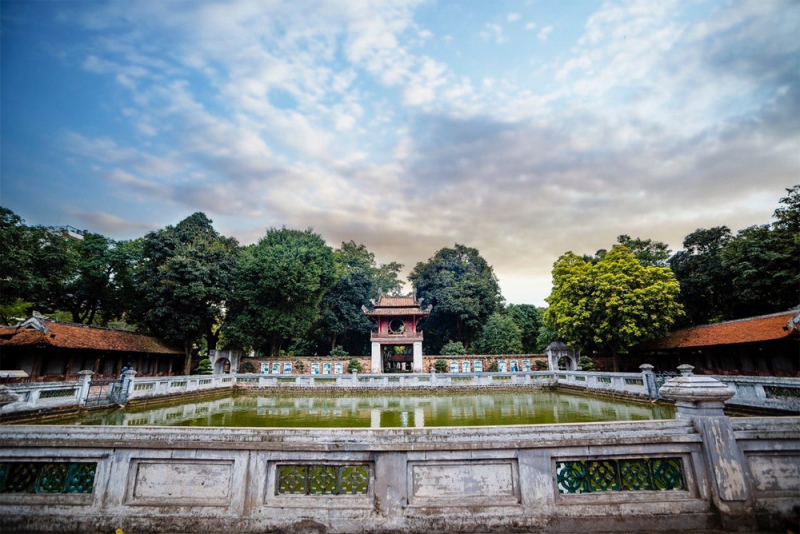
Photo: vietnamtourism.gov.vn 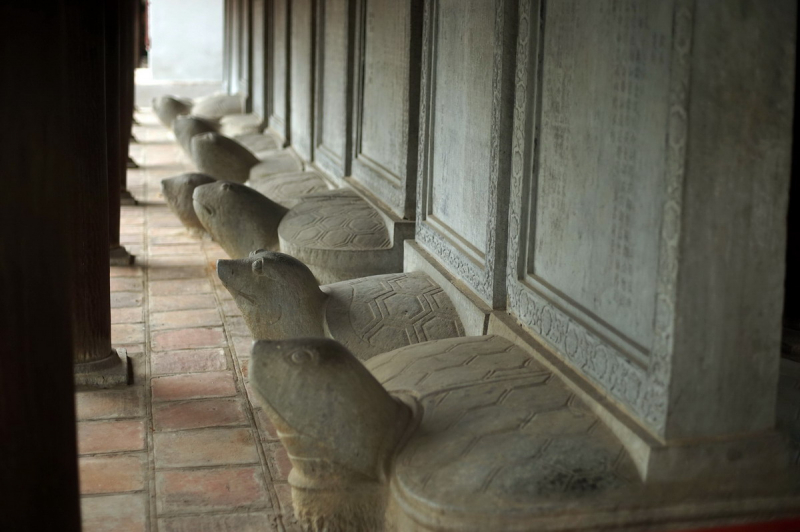
vietfuntravel.com.vn -
The Con Dao Prison Complex were established by the French in 1861 on the Con Dao archipelago. It was primarily constructed to house prisoners who had committed significant crimes and were deemed dangerous by the French colonial authority. They were later utilized, however, to detain political opponents. In these jails, detainees were abused and tormented. These jails were used for the same purpose by the US and South Vietnamese regimes in the 1960s and 1970s. The Tiger Caves, which were discovered much later, are a major attraction in this prison complex.
Although Con Dao Prison Complex have been closed, tragic memories cast a foreboding shadow over this peaceful town. Between 1863 and 1975, the complex was known as "the actual hell on earth," and it housed tens of thousands of Vietnamese inmates who tortured and perished at the hands of French colonials and, subsequently, the US-backed South Vietnamese government. Mannequins bound and deformed bring the terrifying sensation to life.
The jail complex is now a major tourist attraction and one of the most beautiful historical sites in Vietnam, with mannequins positioned to depict the atrocities endured by the inmates. This jail facility is typically free to enter, however there may be a VND 20,000 admission fee on occasion.
Location: Con Dao Prison, Con Dao Island, Vung Tau.
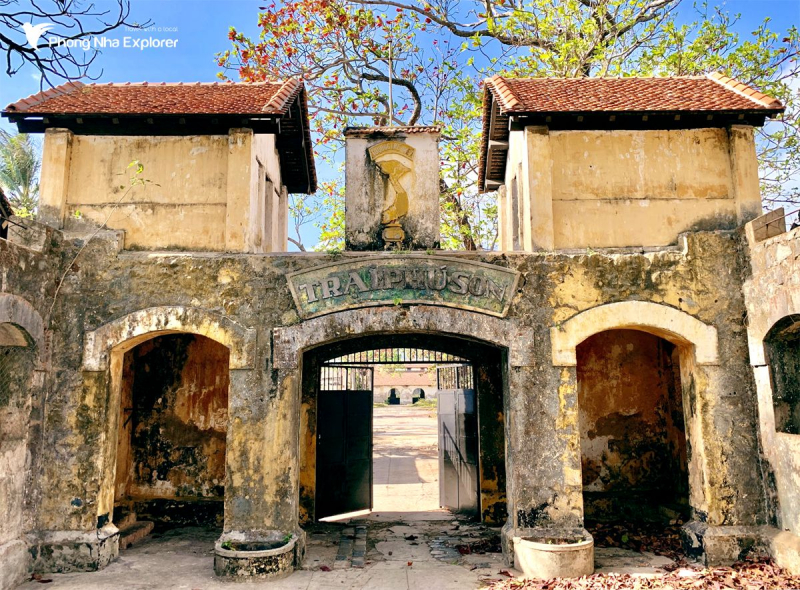
Photo:PhongNhaExplorer 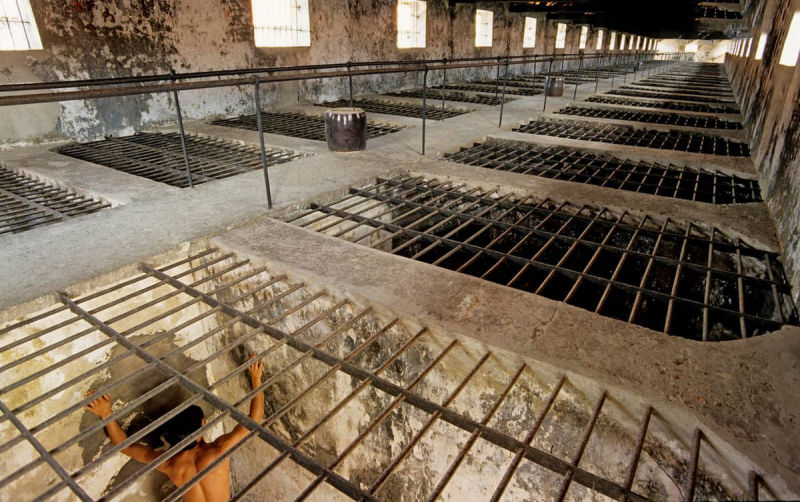
Photo: dulich24h.com.vn -
Among the several royal tombs in Hue, Vietnam's beautiful historic capital, Khai Dinh's tomb stands out with its attractive combination of Asian and European influences. This tomb was erected in honor of Emperor Khai Dinh, the Nguyen Dynasty's twelfth king. Although this tomb is significantly smaller than the previous emperors' tombs, it is more artistically built. The architectural designs incorporate both Oriental and European elements. The tomb has elaborate dragon carvings and an honor guard of bodyguards, elephants, and horses going up to the entrance. The inside has a life-size bronze statue of the late Emperor.
Khai Dinh is the twelfth emperor of the Nguyen dynasty, enthroned in 1916. He was also the last Nguyen dynasty monarch to build himself a "home in another planet." Khai Dinh mausoleum was built atop Chau Chu peak (also known as Chau E), about 10 kilometers from Hue. It took 11 years to build the Khai Dinh tomb, which began on September 4, 1920.
Some of the building materials were purchased in France (iron, steel, cement, and Ardoise tile) and Japan (porcelain and glassware). The tomb of Emperor Khai Dinh is smaller than other tombs in Hue, yet it is more intricate and time-consuming. It is a blend of East-West classic and contemporary architecture.
In general, Emperor Khai Dinh's mausoleum is a rectangular structure with up to 127 steps. Mountains and streams surround Emperor Khai Dinh's mausoleum, creating a spectacular natural setting and Feng-shui aspects. Thien Dinh palace, located at the highest point, is the major architecture of Emperor Khai Dinh's mausoleum. It is divided into five sections: sided apartments for bodyguards, the front palace named Khai Thanh, which is dedicated to the altar and portrait of Emperor Khai Dinh, the middle area, and the emperor's statue and cemetery. Behind the altar lies the late Emperor's altar.
The interior decor of Thien Dinh palace has the highest art value of all. Thien Dinh palace's three central chambers are embellished with china and bright glassware. The one-ton on the bronze statue, in particular, has lovely smooth curves. The late Emperor ordered that a bronze statue of Khai Dinh be built in France in 1922.
Location: Chau Chu Mountain, about 10 km away from Hue City.
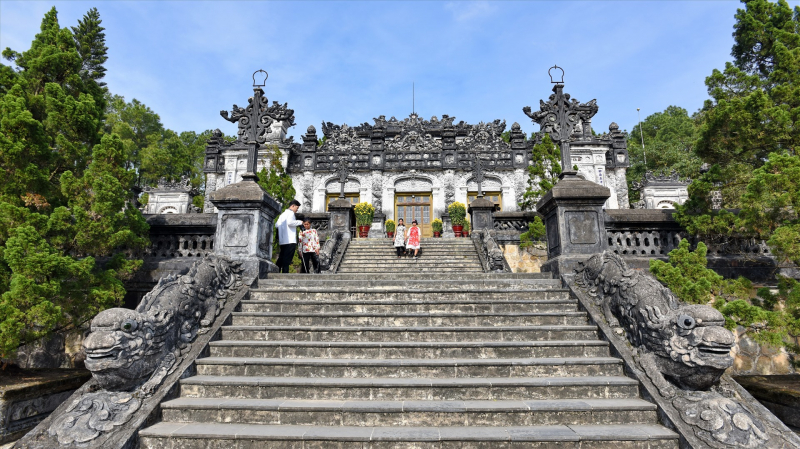
Photo: phuot3mien.com 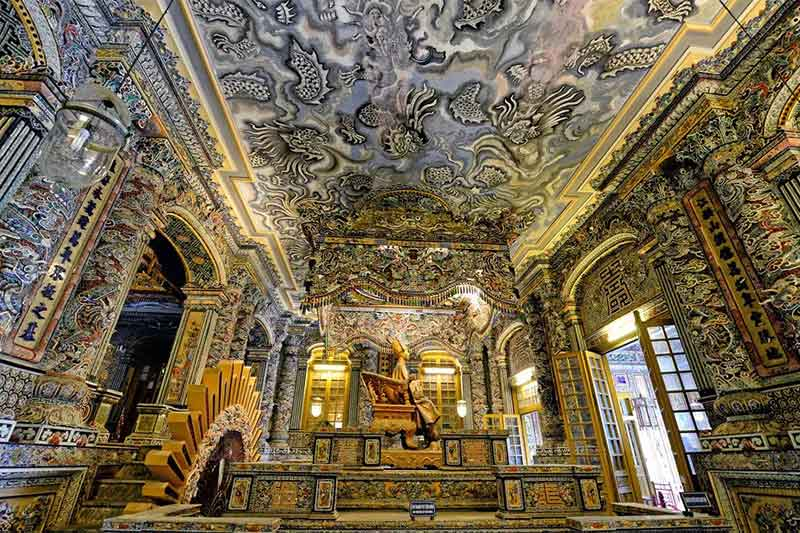
Photo: nadovatours.com -
It is a vast network of the most beautiful historical subterranean tunnels in Vietnam that stretches to the Cambodian border, roughly 60 kilometers northeast of Ho Chi Minh City. During the battle against the French, the Cu Chi Tunnels network was created over 25 years beginning in 1948. It was used to communicate between communities and to assist the Vietnamese avoid scouting French forces.
During the Vietnam War, the tunnel network was extended over a 250-kilometer span. As a result, it became a major element of the Viet Cong combat units' tactics, as well as a home for thousands of soldiers.
Approximately 120 km of the tunnels are still intact and serve as a compelling attraction in Ho Chi Minh City. Hospitals, schools, theaters, and kitchens were all incorporated within this amazing tunnel network. The tunnel openings were concealed by a hidden wooden door and camouflage foliage above. It is so little that only the Vietnamese can fit inside.
Despite their best efforts, the US army was unable to knock the system down completely. The reason for this is that these tunnels were created separately and had many escape routes out to the Saigon River, as well as fake bunkers and booby traps.
There are several unique closed-door buttons put up in various locations around the tunnel system to prevent the enemy and harmful gas from entering. The troops also excavated unnoticed ventilation ducts into the earth and skillfully disguised them. There are also several lethal and frightening traps that have been set up to keep people inside safe.
Visiting the Cu Chi Tunnels allows you to see its distinctive construction and structure, as well as learn why it is significant in Vietnamese history.
Location: TL15, Phu Hiep, Cu Chi District, Ho Chi Minh City
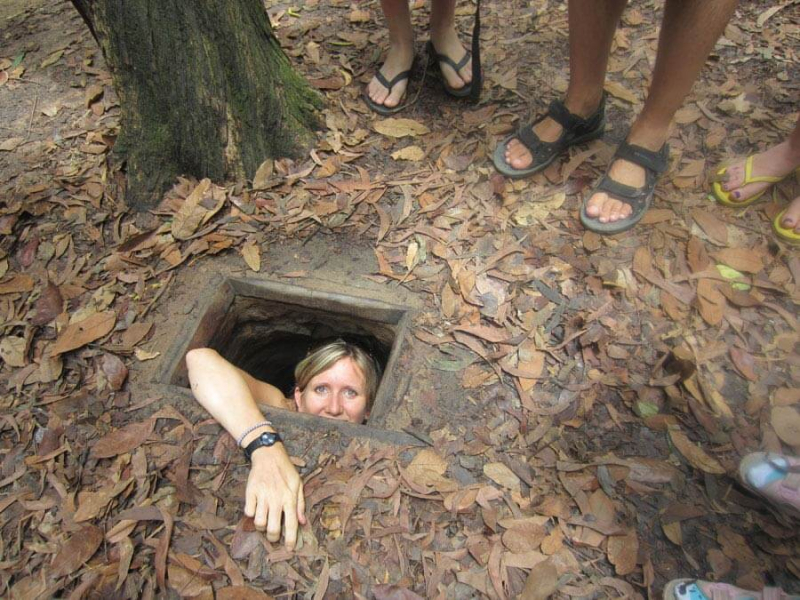
Photo: nhatrangprivatecar.com 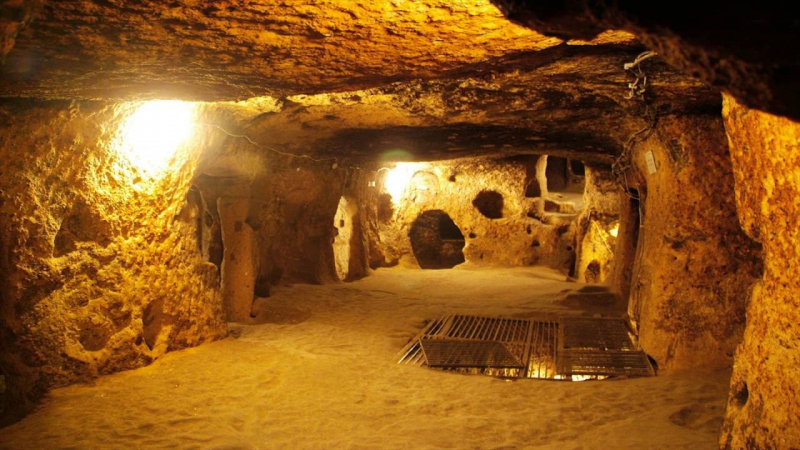
Photo: divui.com -
My Son Sanctuary was built between the fourth and thirteenth centuries CE. The property is located in central Vietnam's hilly border Duy Xuyen District of Quang Nam Province. It is located in a high geological basin surrounded by mountains, which serves as the watershed for the holy Thu Bon river. The Thu Bon river originates here and travels past the monuments, out of the basin, and through the historic heartland of the Champa Kingdom before emptying into the South China Sea at the old port city of Hoi An. The strategic significance of the site is enhanced by its position, which is also readily defendable.
The tower temples were built during a ten-century period in what was the ancestral homeland of the ruling Dua Clan, who unified the Cham clans and formed the kingdom of Champapura (Sanskrit for City of the Cham people) in 192 CE. From the fourth through the thirteenth century CE, this distinctive civilization on the coast of modern Viet Nam traced its spiritual roots to Indian subcontinent Hinduism. Many temples to Hindu deities such as Krishna and Vishnu, but especially Shiva, were erected under this influence. Although Mahayan Buddhism infiltrated Cham culture and grew well entrenched in the north of the kingdom, Shivite Hinduism remained the official state religion.
The My Son sanctuary's monuments are the most important structures and beautiful history of the My Son civilization. The tower temples have a range of architectural patterns that represent the magnificence and purity of Mount Meru, the fabled holy mountain abode of Hindu gods at the center of the cosmos, which is now symbolically duplicated on Earth in the Cham people's mountainous homeland. They are made of fired brick, supported by stone pillars, and adorned with sandstone bas-reliefs representing episodes from Hindu mythology. Their mechanical competence demonstrates Cham engineering talents, while the tower temples' intricate iconography and symbolism provide insight into the substance and growth of Cham's religious and political philosophy.
The My Son Sanctuary is a magnificent architectural ensemble that evolved over a ten-century span. It paints a vivid picture of spiritual and political life during a pivotal period in South-East Asian history.
Location: My Son Sanctuary, Quang Nam Province.
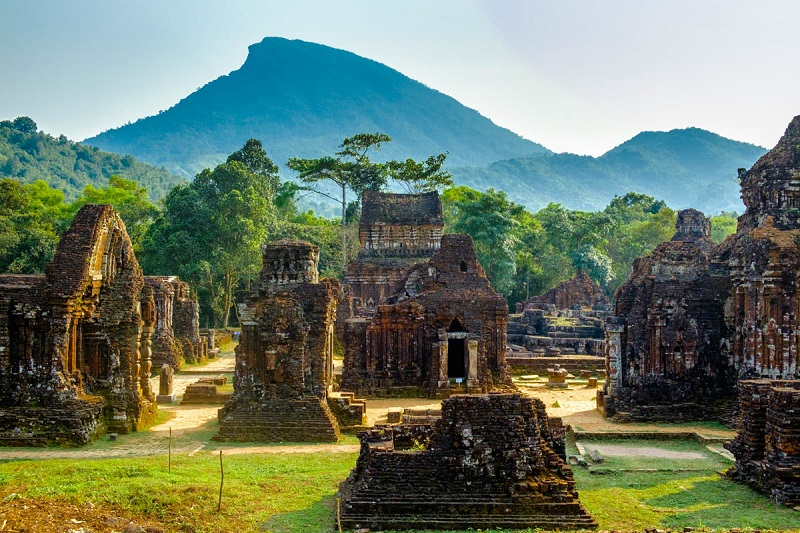
Photo: nadovatours.com 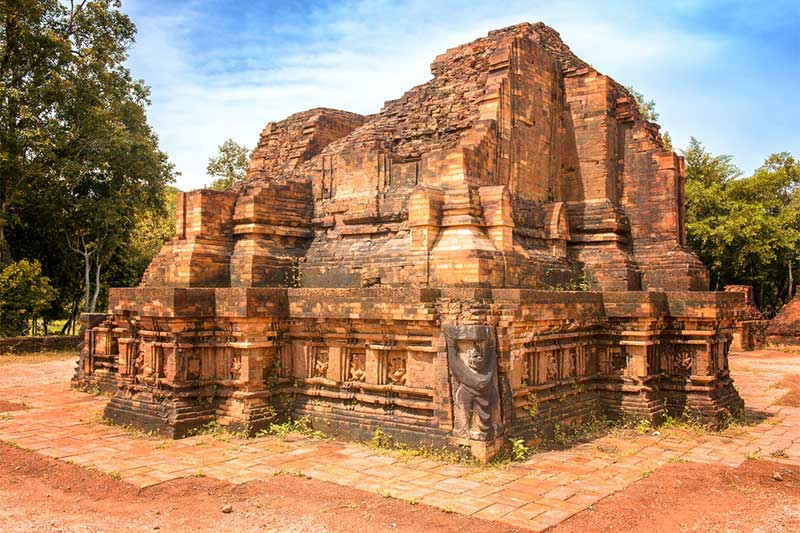
Photo:nadovatours.com -
The Imperial City of Hue, famous for being one of Vietnam's seven UNESCO World Heritage Sites, has long been a must-see sight for travelers exploring the hidden beautiful historical sites in Vietnam. This was a walled stronghold and palace of the historic city of Hue, which served as the capital city of the Nguyen Dynasty for 140 years, from 1805 to 1945.
Gia Long, the emperor who created the Nguyen Dynasty, wanted to build magnificent architecture in 1803. The Imperial City of Hue was ultimately finished under the reign of Minh Mang in 27 years, making it the most colossal edifice being created in contemporary Vietnam history, using thousands of employees, millions of cubic meters of rock, and a large volume of onerous tasks. It is located on the northern bank of the Huong River, which turns south, and has a total land area of 520 hectares. The site was designated a UNESCO World Heritage Site in 1993, with the remaining structures actively renovated and maintained following the damage caused by the Vietnam War.
Hue's Imperial City has a circle of 10 kilometers, a height of 6.6 meters, and a thickness of 21 meters, with forts meanderingly placed, followed by cannons, artilleries, and ammunitions. The fortification was first constructed entirely of earth, and later rebuilt with bricks. The intricate canal system surrounding the city serves not only as protection but also as a waterway with a length of about seven kilometers.
Ten great beautiful gates entrance to the Imperial City of Hue, which is separated into two major areas, excluding residences and mansions: The Citadel and The Forbidden City. The former protected the significant palaces within, while the latter housed the emperor and his family as well as the court's workplace. All of the generally traditional Eastern architecture, such as grand palaces, tombs, and museums, coexist to create an incredibly entertaining destination right in the heart of Vietnam.
Location: the North of Perfume River, Hue City, Thua Thien-Hue Province.
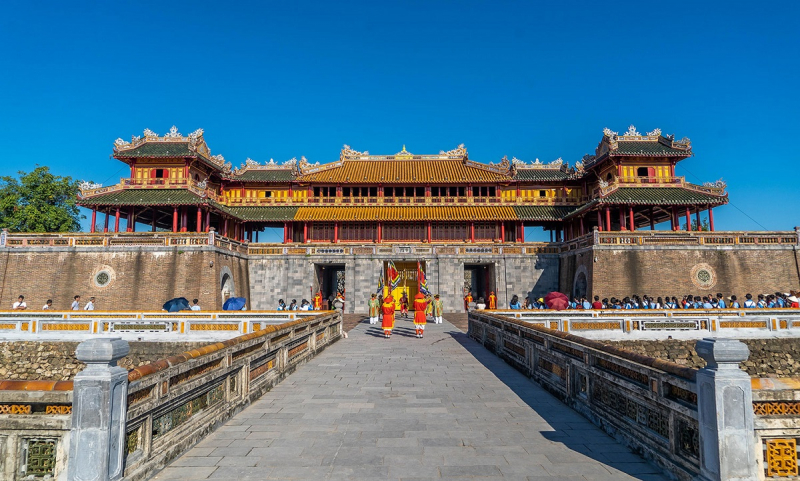
Photo: en.vcci.com.vn 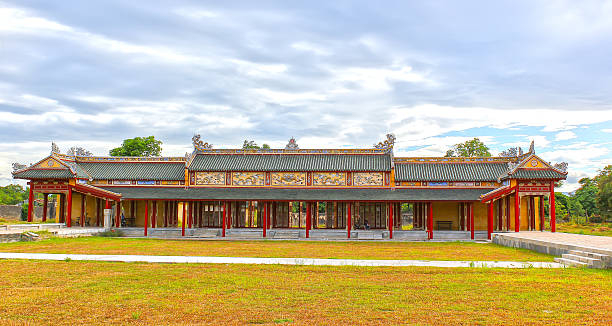
Photo: istockphoto.com -
Hoa Lo Prison in Hanoi is another noteworthy stop on your Vietnam private trip. You may be surprised: a prison in the capital city? That's correct. Indeed, all historical artifacts and antiquities date from the Vietnam-France War and depict the Vietnamese battle for freedom. One horrible antique is the French guillotine, which was used to behead Vietnamese insurgents. Despite numerous recent repairs, Hoa Lo Prison provides a genuine feeling of the glorious past. This historical site also documented the imprisonment of US pilots, including Senator John McCain, as well as the inhumanity and violence that around 2000 Vietnamese nationalist leaders and rebels faced under the French colony.
The French constructed the massive jail complex in 1896. Originally designed to keep 450 criminals, records show that during the 1930s, there were close to 2000 detainees. Hoa Lo was never a particularly effective jail, and hundreds of inmates escaped through sewage grates throughout the years.
Nowadays, Hoa Lo is a tourist attraction with a museum and commercial structures known as the "Hanoi Towers." This jail also has several videos and documentation on Communist soldiers during the Vietnam War. A large number of valuable materials, as well as a scientific show, are on display. Hoa Lo Prison is an outstanding site that should not be overlooked while planning a trip to Vietnam.
Location: 1 Hoa Lo, Tran Hung Dao Street, Hoan Kiem District, Hanoi
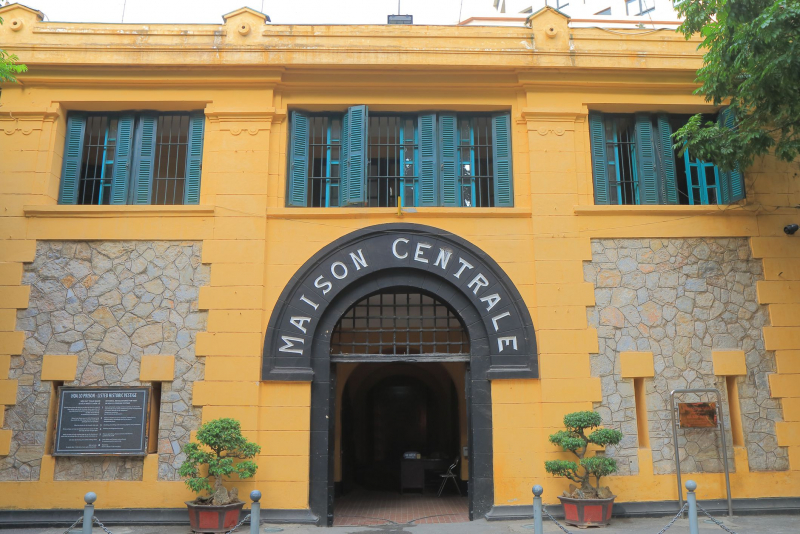
Photo: tripsavvy.com 
Photo:planetofhotels.com -
One of the most valuable and beautiful historical places in Vietnam, The War Remnants Museum were originally known as the Museum of Chinese and American War Crimes, focuses on the American War, although it also covers the French-colonial era and battles with China. Outside are armoured vehicles, artillery pieces, explosives, and infantry weaponry from the United States. One section of the grounds is dedicated to the infamous French and South Vietnamese prisons on the islands of Phu Quoc and Con Son. The guillotine, the most famous of French appliances, and the notoriously horrific 'tiger cages' used to imprison war prisoners are among the artifacts.
The ground level of the museum is dedicated to a collection of posters and images depicting international support for the antiwar movement. This fairly cheerful exhibit serves as a counterpoint to the horrors upstairs.
Some of the photographs on display are disturbing, particularly those of enormous devastation caused by US napalm bombs and the horrifying poisonous effects of Agent Orange on Vietnamese residents. Many visitors may require a respite in between displays. The museum also provides a unique opportunity to view some of the experimental weapons employed in the conflict that were once military secrets, such as the flechette, an artillery round loaded with hundreds of tiny darts.
Look for the Requiem Exhibition upstairs. This fascinating collection, compiled by famed war photographer Tim Page, examines the work of photographers murdered on both sides of the fight, and includes pictures by Larry Burrows and Robert Capa.
Location: 28 Vo Van Tan, District 3, Ho Chi Minh City
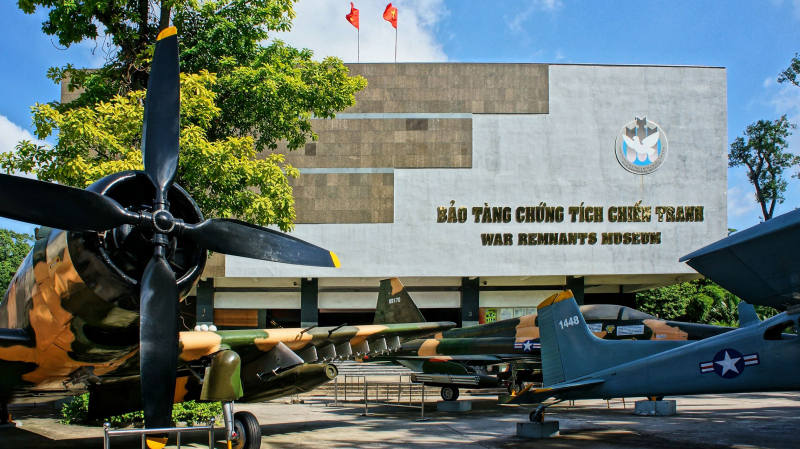
Photo: tripsavvy.com 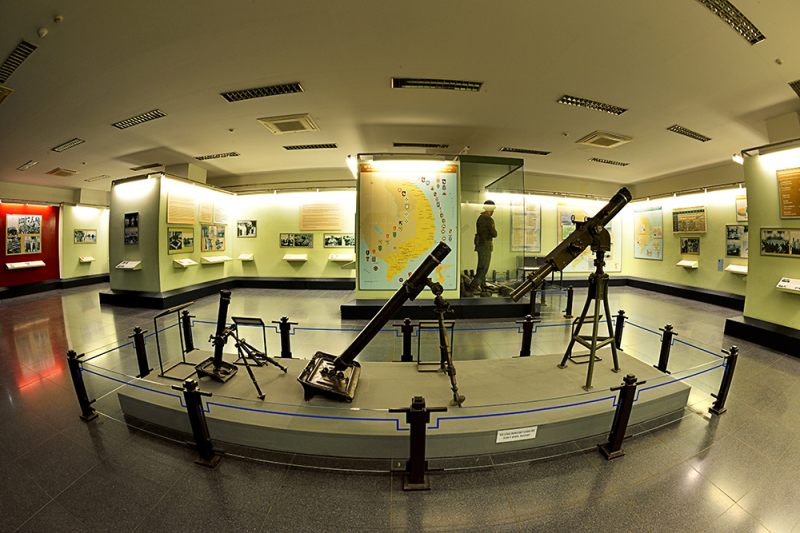
Photo: baotangchungtichchientranh.vn -
Ho Chi Minh Mausoleum is a prudery president Ho Chi Minh body. On September 2, 1973, the tomb was formally inaugurated at the site of the ancient stage in the heart of Ba Dinh Square. On August 29, 1975, the tomb was dedicated. The building architecture consists of three layers, with a height of 21.6 meters and a width of 41,2 meters.
The lowest layer forms the three-level steps, while the middle layer serves as the central framework for the mausoleum and stairs. The mausoleum's outside is gray granite, while the inside is gray and red polished stone.
Marble square columns line the four sides. The upper layer is a leveling roof. The inscription: CHU-TICH-HO-CHI-MINH is carved in pink stone on the front of the tomb. The mausoleum is built to withstand bombs and 7 Richter earthquakes.
There is also flood protection. The tomb will also have a "special chamber" to retain the body in situ in the case of conflict. The tomb was erected on the original foundation of the castle in the heart of Ba Dinh Square, where Ho Chi Minh ruled.
Over large gatherings and read the Declaration of Independence, resulting in the Democratic Republic of Vietnam. The mausoleum is composed of rich Central Highlands woods. The lobby is coated in crimson and rose red marble, and the phrases "Nothing is more valuable than Independence Freedom" are inlaid with gold.
And the Mausoleum's 200 sets of doors are crafted from valuable woods by people from the South and Central Highlands, by carpenters from Nam Ha, Ha Bac, and Nghe An in Vietnam.
Location: 25 Hung Vuong Street, Dien Bien Ward, Ba Dinh Dist, Hanoi.
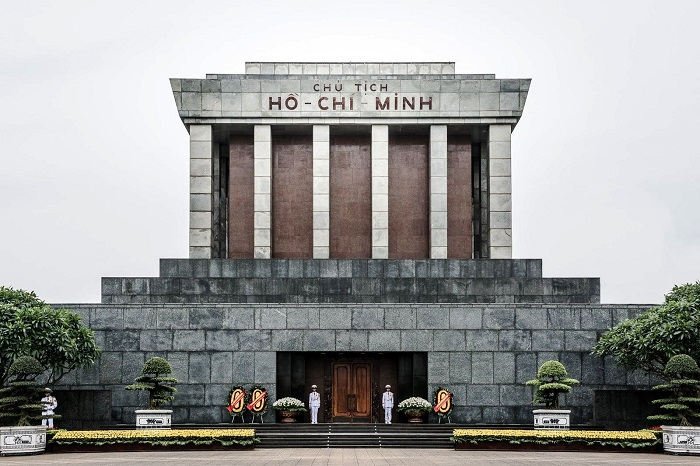
Photo: nhatrangprivatecar.com 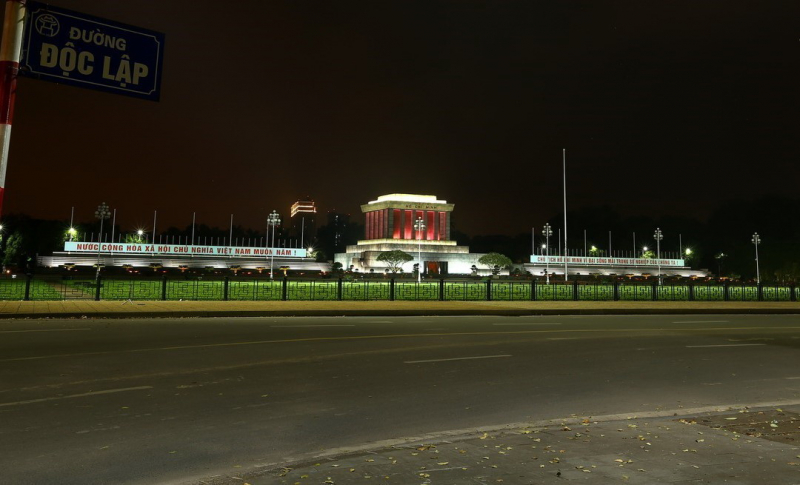
Photo: special.vietnamplus.vn -
It's no surprise that Hoi An Ancient Town is regarded as one of the most beautiful historical cities in Vietnam, with its old-world architecture, cobblestone alleyways, and unique yellow storefronts draped with bright lanterns. At the World Travel Awards in 2021, Hoi An, a UNESCO World Cultural Heritage site since 1999, was voted Asia's Leading Cultural City Destination. But it's more than just prizes and postcard-perfect scenery. The town has a long history of attracting visitors from all over the world.
Archaeological evidence shows that trade occurred in the region as early as the second century BC. Hoi An developed as a thriving trade harbor. It was an economic hub for traders from Asia, Persia, and Arabia during the Cham Dynasties (7th-10th century). Later, ships from Europe began to swarm to the harbor along the legendary Silk Road maritime route. Hi An was a prominent Southeast Asian commercial center from the 15th to the 19th century. Goods were traded here, and ideas and civilizations were exchanged.
The original and undamaged wooden houses and street designs depict a classic townscape of the 17th and 18th centuries, the survival of which is unusual in the region. The town is still populated and used as a trade port and commercial center today. The living legacy, which reflects the different communities of the town's indigenous people as well as outsiders, has also been conserved and is being passed down. Hoi An Ancient Town is a superbly maintained example of a Far Eastern harbor.
Tourism is now the town's main source of income. However, proof of its intriguing history can be seen everywhere. Any of its gorgeous, pedestrian-friendly streets will reveal influences from various ages, regions, and cultures. And, with its numerous shop-houses, it is still regarded as a paradise for acquiring silk and other valuable products.
Location: Hoi An City, Quang Nam Province.
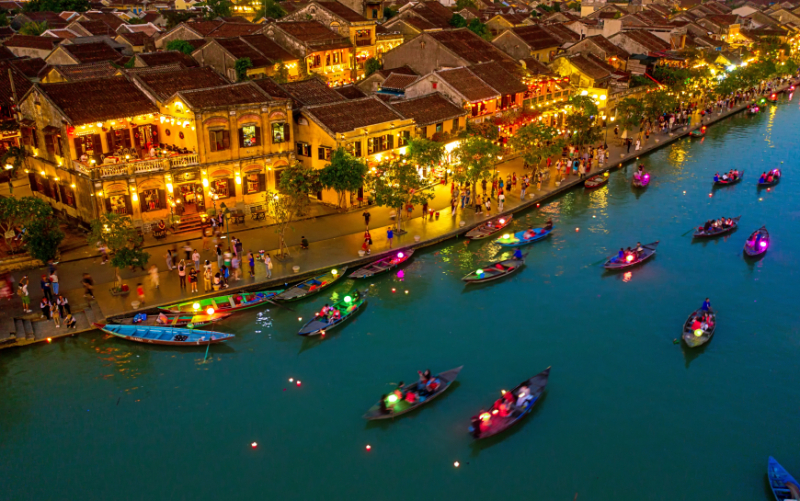
Photo: vietnam.travel 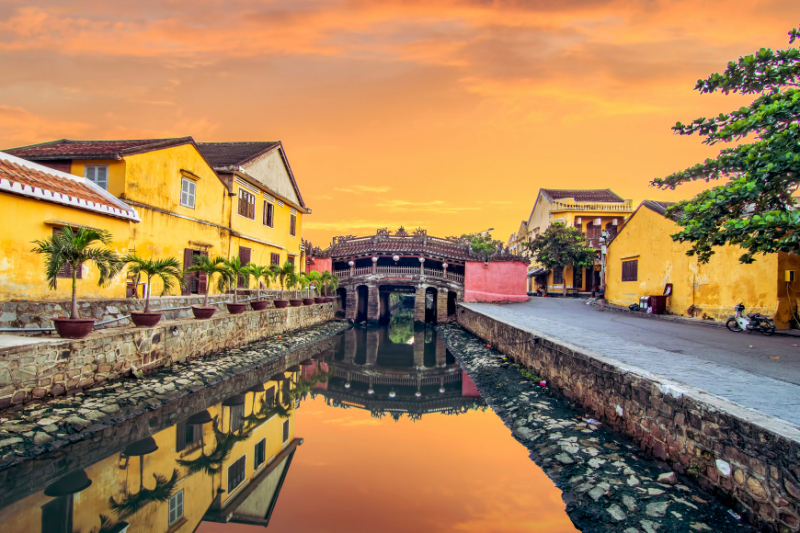
Photo: vietnam.travel































